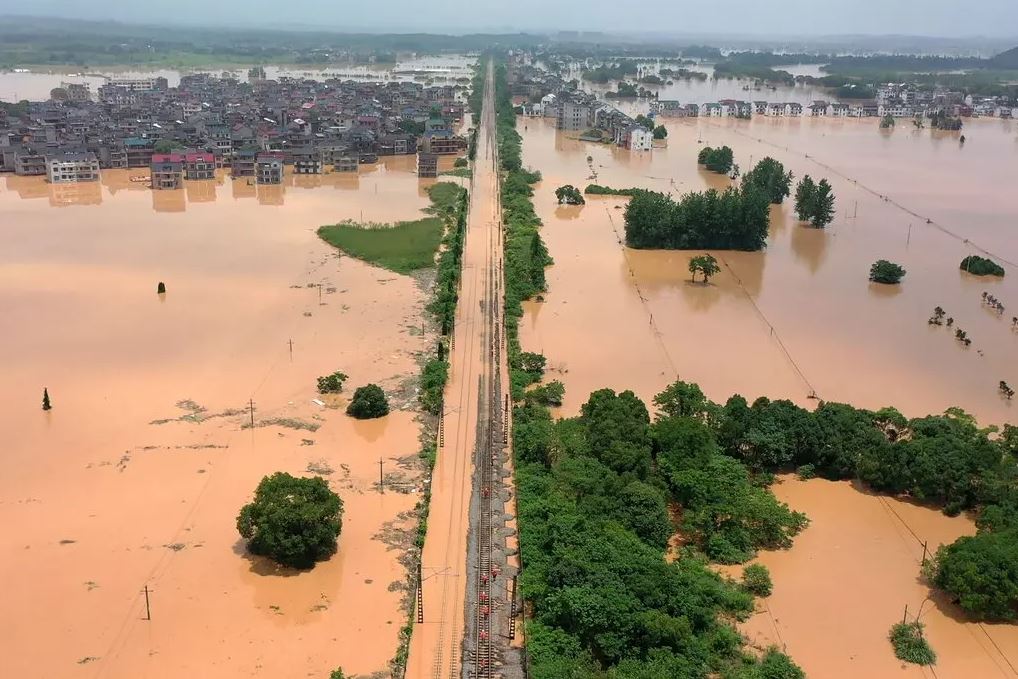In the southern part of the country, the worst flooding in decades has submerged houses and cars, and in the northern and central provinces, record-high heat waves have caused roads to buckle and are causing temperatures to soar to dangerous levels. China is currently dealing with a number of severe weather emergencies across the country.
According to the People’s Daily, the official newspaper of the Communist Party in power, the water levels in more than one hundred rivers around the nation have risen to levels that warrant the issuance of flood warnings. After several days of rain and flooding, the authorities in Guangdong Province on Tuesday upped the alert level to the highest possible level, which resulted in the closure of schools, businesses, and public transportation in the districts that were impacted.
The floods in southern China has caused significant disruption to the lives of almost half a million people. The footage that was shown on state TV showed rescue teams in boats paddling through roads that were flooded in order to free citizens who were stuck. According to state media, firms in the city of Shaoguan, which is a manufacturing centre, have been instructed to stop operations because water levels had reached their highest point in half a century.
According to the official Xinhua News Agency, the disaster management department of Guangdong said that the rains has impacted 479,600 people, destroyed over 30 hectares of crops, and caused the collapse of more than 1,700 dwellings, resulting in a total of $261 million in financial damages.
The midsummer flooding problem has plagued China for generations, but this year’s floods have also coincided with heat waves that have slammed the northern half of the nation. According to the Central Meteorological Observatory, heavy rain is forecast to move into that region in the coming days.
In nine northern and central provinces, the mercury soared to a high of 104 degrees Fahrenheit on Tuesday. Local media have stated that roadway surface temperatures in Henan that reached as high as 165 degrees Fahrenheit caused fractures in cement roads last week, similar to the damage that would be caused by the aftermath of an earthquake.
Premier Li Keqiang made the statement on Tuesday when he was inspecting a thermal power firm that the nation has to boost the capacity of its coal output in order to avert power disruptions.
This year’s floods and heat waves in China have lasted for days and weeks, just like they did last year. Last year, weeks of flooding killed hundreds of people, caused power outages, and displaced millions in central and southwestern China, including in Zhengzhou, where floodwaters trapped commuters in subways. This year, the floods and heat waves in China have lasted for days and weeks.
The two-pronged weather emergency that China is now facing is a reflection of a worldwide trend that may be attributed to climate change, which is that of more frequent and prolonged occurrences of severe weather.
Over the course of the last several decades, China has transformed farmlands into urban regions, helping millions of people in rural areas to escape poverty. However, in its pursuit of economic progress, it has also become the world’s top polluter, with greenhouse gas emissions that surpass those of all industrialised countries combined. This is a consequence of its economic success.
Since then, Xi Jinping has been the first leader of the country to publicly commit to addressing climate change as a top national priority. In an effort to reduce emissions, China launched a carbon market in July of last year. Additionally, the country’s urban areas have roughly five times as much green space as they had 20 years ago.
But there has already been a substantial amount of harm done to the ecosystem. The destruction and disruptions that have already resulted from the emission of greenhouse gases are expected to continue in the years to come as a direct consequence of these emissions.

